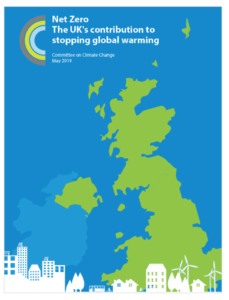The Committee on Climate Change said the UK should aim to eliminate net emissions of greenhouse gases by 2050. This would mark the end of the UK’s contribution to global warming. However, the Renewable Energy Association say this is impossible without bio-energy.
What is Bio-energy?
Bioenergy relates to electricity and gas that is made from organic matter, known as biomass. Plants, timber, food waste even sewage can all be considered biomass.
How does Bio-energy work?
Dry, combustible feedstocks (biomass) such as, but not limited to, wood pellets are burnt in boilers or furnaces. This in turn boils water and creates steam, which drives a turbine to generate electricity.
The Renewable Energy Association states thats bio-energy offers an immediate and affordable way to cut emissions, especially for the hard-to-decarbonise heat and transport industries.
 Committee on Climate Change – Report: May 2019
Committee on Climate Change – Report: May 2019
The Committee on Climate Change has produced a report in May, which reassesses the UK’s long-term emissions target. The key findings of this report are:
- The Committee on Climate Change recommends a new emissions target for the UK: net-zero greenhouse gases by 2050.
- In Scotland, they recommend a net-zero date of 2045, reflecting Scotland’s greater relative capacity to remove emissions than the UK as a whole.
- In Wales, they recommend a 95% reduction in greenhouse gases by 2050. Wales has been recommended to have “only” a 95% target reduction by 2050, as it less opportunity for CO2 storage, and also has relatively high agriculture emissions, making a 100% reduction much less likely than Scotland and England.
A net-zero target for 2050 will deliver on the commitment that the UK made by signing the Paris Agreement. The Paris Agreement aims to keep a global temperature rise this century well below 2 degrees Celsius above pre-industrial levels, and to make efforts to limit the temperature even further to 1.5 degrees Celsius. A number of countries, including the UK signed up to this agreement in 2015.
How damaging is climate change?
1.0C increase – Damaging effects are being seen even at this 1 degree C increase.
1.5C increase – Keeping below 1.5°C would limit many important risks further, helping to protect key ecosystems and reducing impacts on poorer people around the world.
2.0C increase – The world has committed to reduce emissions faster to keep warming ‘well-below’ 2°C. This would help limit the most damaging effects of climate change.
3.0C increase – The world is moving towards a low-carbon future, reducing some risks. We are currently on track for around 3°C of warming by 2100.
4.0C increase – Unchecked emissions growth would lead to very severe and widespread climate change at 4°C or more by 2100.
The Net Zero target is only realistic, it’s been reported, if policy to reduce emissions is significantly increased across the UK. The discussion about bio-energy further comes into consideration here, as this approach to drive down emissions is both feasible and realistic. According to the Renewable Energy Association, bio-energy technologies such as modern biomass boilers, biofuels and anaerobic digestion can make an affordable means to provide instant carbon reductions.
A new industry led report from the Renewable Energy Association has found that sustainable bioenergy can meet two thirds of the projected shortfall of the 5th Carbon Budget. Furthermore bio-energy can provide an extra 60 TWh of heat and 57 TWh of power, which is more than enough to close the nuclear gap.
More information and insight will follow as these discussed points progress…








